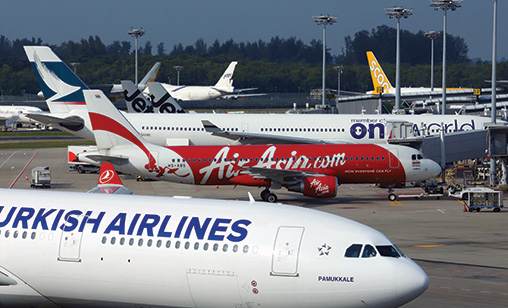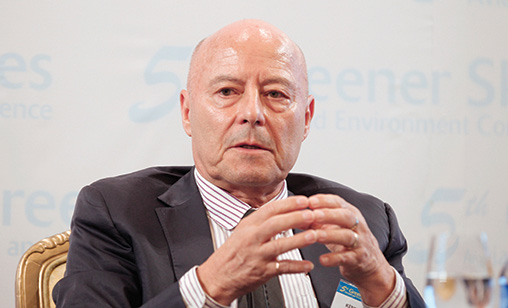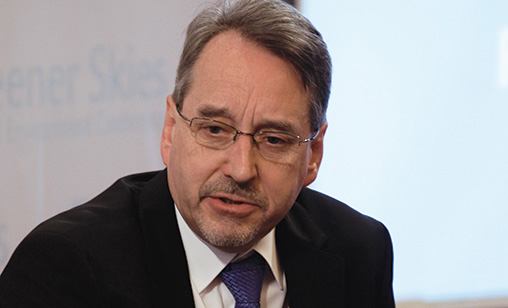Main Story
UNDER THE SAFETY MICROSCOPE
Airline and national regulatory bodies are working towards “Seamless Skies”, but it will be several years before they become a reality. In the meantime, airlines are stymied by mismatched and widely divergent standards of air traffic technology and safety regulations.
March 2nd 2015
In January, when AirAsia group chief, Tony Fernandes, called for a Southeast Asian regional aviation regulator to streamline the region’s fragmented safety framework, it was not the first time such a plan had been mooted. Read More »
 |
Fernandes made his plea in the wake of the Indonesia AirAsia A320 accident that took the lives of 162 passengers and crew. And he was speaking not only from the heart but from experience.
For all those involved in investigating the Indonesia AirAsia crash into the Java Sea on December 28, including AirAsia’s management, it became clear that the Air Traffic Management system of Indonesia, like several others across the region, was operating under stress that often was extreme.
In 2013, when the Asia-Pacific’s director generals of civil aviation (DGCA) gathered for their annual meeting, held that year in Bangkok, Indonesia proposed a similar regional body to Fernandes’s suggestion, but the idea was rejected. Many delegates believed it would add another layer of bureaucracy to a system already burdened with rules and regulations that varied between countries and jurisdictions.
Orient Aviation has learned that when the DGCAs again met, in Hong Kong last November, representatives of the Civil Aviation Administration of China (CAAC), also suggested a regional body should be set up, although there was no formal submission made. Industry insiders expect China will return to this year’s conference with a more formal proposal for Asia-Pacific DGCAs to consider.
Whether the influence of China will persuade doubters to set up a regional air safety body remains to be seen, but the Indonesia AirAsia tragedy has again concentrated the spotlight on inefficiencies and inadequacies of an air traffic system that is choking from congestion in several flight zones across the region.
While the industry awaits Indonesia’s release of the final report into the IndonesiaAirAsia loss, it is now better understood that cockpit crews experience long delays in awaiting air traffic control clearance when they request permission to change altitude or alter course. Basically, air traffic controllers have too many planes to manage often with outdated systems and equipment.
With hundreds of aircraft scheduled for delivery to the region’s carriers in the coming decades, including a giant order from Indonesia’s Lion Air Group, the situation can only worsen. The Asia-Pacific accounts for 31% of global air passenger traffic, according to the International Air Transport Association (IATA). In 20 years that figure is forecast to be 42%.
But this explosive growth is only part of the problem. Lack of regulatory oversight of airlines in some countries remains a major issue when it comes to air safety in the region. A U.S. Federal Aviation Administration (FAA) safety downgrade of Philippines carriers was lifted only last year. A ban on Indonesian carriers by Europe remains in place, although a small group of Indonesian airlines, including Garuda Indonesia have been exempted from the ban.
Now, although there has no been an official announcement, it is understood the International Civil Aviation Organization (ICAO) is considering a downgrade of Thailand’s safety rating following an audit conducted in January (see page 14).
Industry experts point out that Seamless Skies and proposals for some sort of overall regional regulatory body are different issues. In Asia, there is no plan to move towards a Single Sky as is the goal of Europe, which is a single community. The U.S. is different again because it has the FAA.
 |
| 'What we’ve seen around the Asia-Pacific is that each state is in various stages of upgrade or has obsolete equipment. There’s a mismatch of technology between states. In some places, the equipment is old, sometimes very old' |
| Ken McLean IATA Asia Pacific regional director for safety, operations and infrastructure |
In the Asia-Pacific, the strategy is focusing on Air Traffic Flow Management (ATFM) between national Flight Information Regions (FIR). The main reason? Because individual countries jealously guard the sovereignty of their own air spaces.
Director general of the Association of Asia Pacific Airlines, Andrew Herdman, said: “Congestion is a major concern in China, for example, where traffic growth has been tremendous. We also see it in congested air routes around other parts of Asia and indeed other parts of the world. The challenge is, as the traffic growth continues, for air navigation services to keep up.”
At present said Herdman, all air traffic control is ground based instruction. If requests are made controllers have to work out conflicting traffic, which can involve other air traffic navigation service (ANSPs) providers. “Obviously, that takes time,” he said.
“It’s all done by voice communication between the ground and the aircraft and between different providers. It’s far from being automated so that’s why these things take time. The more congested it is, the more troublesome it may be,” he said.
The International Air Transport Association’s (IATA) Asia-Pacific regional director for safety, operations and infrastructure, Ken McLean, said each state has an obligation under ICAO to deliver Air Traffic Control (ATC) services within the standards and practices laid down by global organization.
“How they do that is up to the state. But what we’ve seen around the Asia-Pacific is that each state is in various stages of upgrade or has obsolete equipment. There’s a mismatch of technology between states. In some places, the equipment is old, sometimes very old,” said McLean.
“Two things happen. One, it is not reliable so they have to exercise caution about the separations standards they can apply. Secondly, in many countries the air traffic controllers – this is not a reflection of their ability – are dealing with very rapid expansion.
“The traffic is growing quickly, but they are operating with obsolete equipment. If they are not provided with a modern suite of tools then [to manage air traffic demands] they will impose additional separations above the operating norm for safety reasons.”
“Some countries will impose a 30 nautical mile separation, but with good technology and capability, they could allow 10 to 15 nautical miles between aircraft, which would result in an immediate increase in capacity. There is a wide range of capabilities across the region that creates problems as aircraft transit from one to the other,” McLean said.
Despite these funding and logistical obstacles, progress is being made in achieving Seamless Skies, which was set in motion in 2009 at a meeting of the region’s DGCAs in Japan. It was agreed a plan should be developed in accordance with ICAO’s system of bloc upgrades.
“Essentially, these bloc upgrades advise that countries implement today what can be used today,” explained McLean. “In other words, with no new technology on the aeroplane and not much new technology on the ground we should do today what we can.
“And one of those things is air traffic flow management (ATFM). IATA financed a study last year, with ICAO’s agreement and with the States’ involvement, intended to develop Asia-Pacific ATFM.
“We are now embarking on stage two, which is how we implement the plan. By the end of this year, with ICAO’s support, a good implementation plan should be set out. Then comes the challenging part: for all of the states to meet their obligations in accordance with that plan.”
 |
| 'Obviously, the recent accident in Indonesia highlighted again that Indonesia is among the poorer performers in terms of regulatory oversight. They have an action plan, but they still have a lot of work to do' |
| Andrew Herdman AAPA director general |
Herdman said: “There’s been a lot of multilateral activity, involving small clusters of countries in North Asia and Southeast Asia. I notice, from the reports that come out of the annual meeting of the director generals of civil aviation, that the number of countries involved in those activities is growing.
“It might involve five or six countries or authorities working together to change procedures. It essentially means that the flow is optimized, even though it’s kept going through several different FIRs,” he said.
McLean said IATA has been working with a North Asia group made up of China, Hong Kong, Korea and Japan, a southern group including Australia, Indonesia and the Philippines, and a South China Sea group of Hong Kong, Singapore and Thailand.
“Between them, they are working on their own flow management agreements and will eventually join up. Not many states have their own internal flow management. So, for a start, they have to sort that out and then agree with their neigbours about the best means to exchange information.
“The most mature group, involving Hong Kong, Singapore and Thailand, will conduct trials later this year.We want to bring all that good effort together into a regional plan so we don’t end up with different outcomes in each of these pockets.”
As for a regional regulator, it appears it will be even harder to achieve than Seamless Skies. “It’s time for Asean institutions to step forward, for commonality, for standardization and for quality,” Fernandes said. “We should have one Asean regulator for air traffic, one Asean safety standard and one pilot training qualification, so there will be mobility of workforce.
“So Asean is not just about Open Skies (to be implemented this year), it’s about having Asean standardization and institutions to advance the Asean aviation industry.”
Herdman said there are discussions taking place among Asean member countries about harmonization of regulatory oversight, including licencing of pilots, engineers and MRO facilities.
“Asean is very, very diverse in its development and capabilities. In Europe each country has its own regulatory oversight and they are all national authorities. Over time, they centralized into EASA (European Aviation Safety Agency) and transferred responsibility from the nation States into that regulatory authority.
“The necessary first step to that end is that regulatory oversight performance is comparable across the different countries. In Asean, until you have more commonality of performance, it is premature to believe you could move to a set of standards. There won’t be agreement.
“The more developed States, who score better in ICAO audits, regulatory oversight, implementation of ICAO standards and guidelines, would want a high standard established and would not accept a lower standard.
“So, if there is disagreement about an appropriate standard and how it should be enforced, you have to recognize there will be political difficulties that will take effort to overcome.”
Herdman believed the first step towards a regional body would be to recognize countries that are below average. “Obviously, the recent accident in Indonesia highlighted again that Indonesia is among the poorer performers in terms of regulatory oversight. They have an action plan, but they still have a lot of work to do.”
McLean said he certainly sees the advantages of a regional body. Although ICAO provides rules for civil aviation, each state implements them in its own way and a body that could harmonize the rules between the states would be beneficial, he said.
“It would, however, be difficult initially to secure agreement across the entire region. Asean, as it moves into Open Skies, perhaps could provide an opportunity to set something up that could be expanded to other parts of the region,” he said.
Another industry challenge is ensuring standardization is established for the satellite systems being developed to improve ATC and aircraft tracking. Communication providers such as Inmarsat and Iridium are launching constellations of satellites, but they won’t be ready for full operations until 2017-2020.
“There is rivalry between the different consortia. A degree of competition is helpful, but we want common standards. You don’t want to equip aircraft with multiple boxes for different schemes. If you look at ADS-B (automatic dependent surveillance – broadcast) it is implemented in slightly different ways in different parts of the world, which is obviously a headache for global carriers that operate worldwide,” said Herdman.
Upgrading the system isn’t an easy task. “We are talking about a global system that is not based on ground-based stations. It has to have a satellite component to it and the system has to keep operating with 100,000 flights a day, ranging from modern commercial jets to much smaller aircraft which may not be equipped. So, you’re not allowed to stop the system at any time to switch to a new type of technology,” said Herdman.
“In a way, it’s deeply conservative. You have to keep maintaining the system as it is and embrace new layers of technology and adoption. But you can’t give up. You can’t obsolete the older methods because these still underpin vast amounts of aviation.”
| Thailand threatened with ICAO air safety downgrade The director general of Thailand’s Department of Civil Aviation (DCA), Somchai Piputvat, has downplayed reports that the International Civil Aviation Organization (ICAO) could downgrade the country’s air safety rating following an audit of Thailand’s safety systems in January. Although the United Nation’s aviation body has not formally released its findings from the audit, it is understood some serious safety concerns arose, including a lack of oversight personnel and the fact the DCA did not send staff to ICAO-sanctioned training on specific aviation standards, but nevertheless issued licences covering these standards. Somchai told local media his department had issued safety licences to 10 airlines operating international flights, 10 domestic and chartered airlines, and one cargo carrier. It also checked the safety standards of other relevant operators, including Aeronautical Radio of Thailand, Airports of Thailand, hangar operators and agencies responsible for aviation training. He said ICAO may have reservations about air-safety standards in Thailand, but his department had high standards of aviation certification. ICAO, he added, also might be concerned about the role of the DCA, as it acts both as aviation regulator and operator of 28 regional airports. Those dual roles, he speculated, might represent a conflict of interest. While Somchai said he personally believed the department’s regulatory and operating roles should be separated, it would be difficult to achieve because other operators, such as Airports of Thailand, would not be interested in running some of the loss-making regional airports that are kept open for public and security reasons. ICAO was scheduled to hand over its audit report to Thai authorities by the end of last month. The DCA will then have 15 days to respond and propose measures to resolve any issues. If the issues are not resolved, ICAO will publish the findings on its website at the end of May. By Tom Ballantyne. |